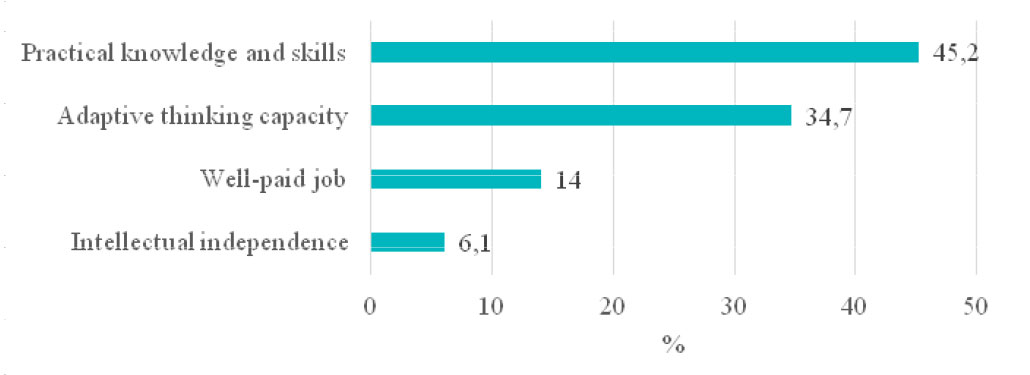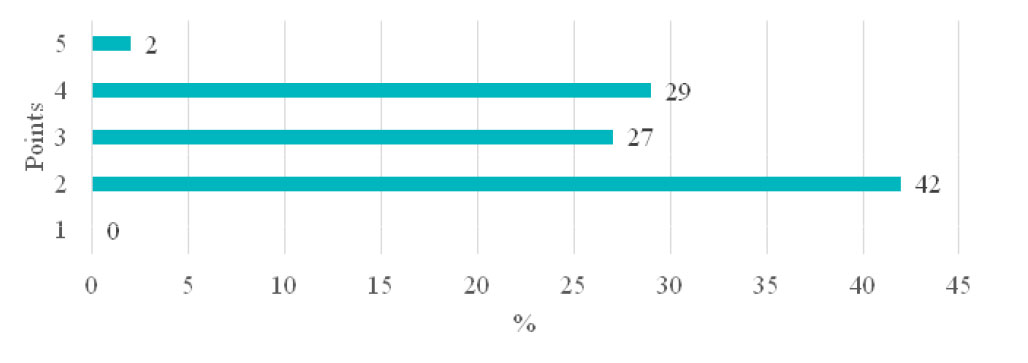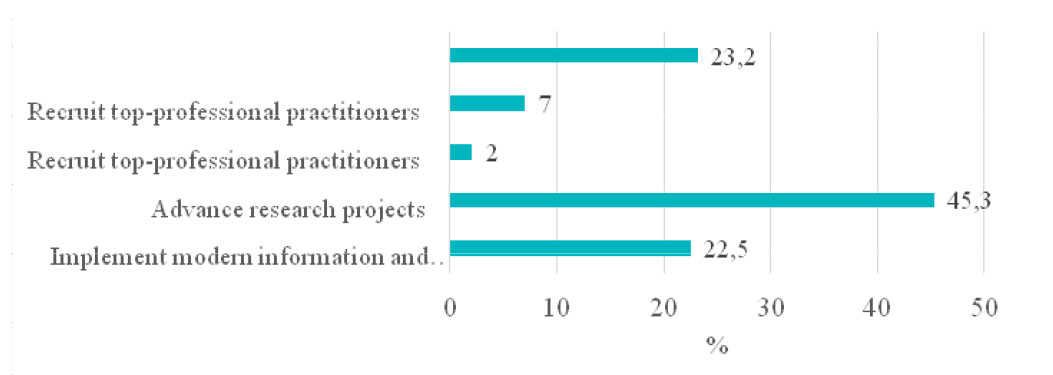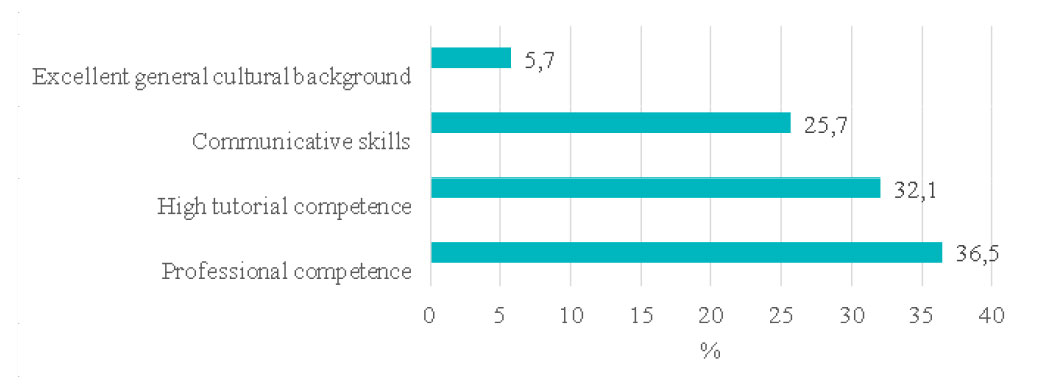Physical Education Quality Determinants According to Students
ˑ:
PhD, Associate Professor D.N. Koval1
PhD, Associate Professor R.V. Gziryan1
PhD, Associate Professor G.V. Shiyanova2
PhD, Associate Professor A.P. Babchenko2
1North Caucasus Federal University, Pyatigorsk
2State University, Pyatigorsk
Keywords: physical education service, physical education service quality rating, satisfaction with quality, satisfaction markers, physical education service quality determinants, information and communication technologies.
Background. One of the top priority topics for the education research community is the education service quality, with the modern education service quality expected being competitive on the global markets for the top-priority national strategic human resource policy goals being attained [5] among the other key education service pillars including the service accessibility, mobility. interdisciplinary design etc. The still inconsistent interpretation of the education service quality concept may be explained by the following key factors as provided by D. Adams [15]: (1) multidimensionality and dynamism (in timing and contextual terms) of the concept; (2) plurality of interpretations that may imply the national/ communal or individual values; (3) the concept may be spelled out in the quantitative or qualitative criteria; 4) the quality-related goals may come in conflict with the efficiency, fairness etc. related ones.
It is obvious in this context that every actor of an education service system may come up with its own set of education service quality determinants/ markers/ satisfaction rating criteria [14], i.e. every actor may have a different view on the education service quality standards and, hence, the education service quality improvement issues. We believe, however, that a decisive role in the education service quality rating (i.e. the education background with the theoretical and practical competences and skills) efforts will be given to students [11]. Having analyzed the national and foreign study reports with concern to the factors of influence on the individual/ communal satisfaction with the education service quality standards, we found a wide range of approaches to the education service quality rating criteria – that still largely fail, however, to assess the education service quality from the viewpoint of the education service consumer [1-4, 6-9].
Objective of the study was to find the education service quality rating criteria/ determinants based on the students’ education service quality satisfaction survey.
Methods and structure of the study. The students’ satisfaction survey was run in February to March 2019 on a sample of 1-4-year bachelor students (n=1230) from the following Pyatigorsk-based higher education establishments: Pyatigorsk State University; North Caucasus Federal University; Service and Technology Institute; Service, Tourism and Design Institute; the Plekhanov Russian University of Economics Affiliate. The survey form included direct (‘projective’) and indirect questions to rate the following physical education service quality aspects/ parameters: (1) degree of satisfaction with the physical education service quality on a 5-point scale; (2) factors of influence on the physical education service quality satisfaction; (3) physical education service quality improvement actions recommended by the respondents; and (4) qualities, skills and other credential of an ideal teacher.
For the survey data processing purposes, we used a few categories to facilitate the content analysis, semantic interpretations, graphical presentations and rankings of the survey data. It should be mentioned that we used a combined sample including respondents from a few age groups.
Results and discussion. We ranked the determinants/ criteria to rate the university competitiveness on the modern education service markets within the relevant service limits (‘frontiers’) and students’ satisfaction ranges as presented on Figure 1 hereunder

Figure 1. Distribution of the competences ideally secured by a high-quality education service as reported by the sample %
As demonstrated by Figure 1, 45.2% of sample gives a special priority to the practical knowledge and skills provided by the academic education service. Given on Figure 2 hereunder are the quality scores of the knowledge and skills provided by the universities, on a 5-point scale.
.
Figure 2. Quality scores of the knowledge and skills provided by the universities, points on a 5-point scale versus % of the sample
Furthermore, we tried to find the potential ways for the education service quality improvement by surveying the sample on the education service quality improvement actions they would recommend to cope with the existing problems and secure the service progress: see Figure 3.

Figure 3. Physical education service quality improvement actions recommended by the sample, %
The survey data show a high demand for the modern information and communication technologies that could, in opinion of the respondents, decisively improve the education service quality standards. It is also clear that the students give a special priority to the personal credentials of the faculty on the whole and physical education service faculty in particular reporting the need for the top-professional practitioners (22.5% of the sample). The teacher’s personality determinants are viewed as dominated by the professional qualities (36.5%) and pedagogical competency (32.1%): see Figure 4.

Figure 4. Ideal teachers’ credentials to secure the education service quality standards, %
The survey data demonstrate that the education service quality standards will be secured, in opinion of the sample, by the highly competent faculty having high professional, tutorial and communicative competencies. Therefore, we would recommend giving a special priority in the human resource recruitment process to the candidate teachers’ portfolios and the competence assurance credentials.
It should be emphasized that the survey revealed highly pragmatic attitudes of the sample to the practical physical education service knowledge and skills expected from the education service – in view of the growing competition in the social environment on the whole and on the labor markets in particular – that might be the prime reason for the students’ growing demand to the practical aspects of the education service quality standards. Being on the forefront of the modern information and communication technologies, the students demonstrate the natural need for the education service digitalization in every institutional aspect. The academic communities need to meet this demand by the persistent efforts to facilitate the education service by the top-notch information and communication technologies to put their universities in better competitive positions on the modern education service markets and secure their progresses in a long run.
Conclusion. The student satisfaction survey data, analyses and findings may be of special practical interest for the relevant education service contributors including the university management, education service quality assurance personnel, human resource service management officers and other faculty members. We believe that further research of the academic education service quality from the standpoint of the ‘end consumer’ of the service is of high promise of the education service quality improvement initiatives.
References
- Bratishchenko D.V. Globalization and problems of higher education in Russia. Nauchny vestnik Moskovskogo gosudarstvennogo teKhnicheskogo universiteta grazhdanskoy aviatsii. 2014. no.203. pp.4955.
- Gladkova M.V. Quality of university services: student point of view. Prakticheskiy marketing. 2007. no. 5. pp. 3035.
- Gordienko T.P., Smirnova O.Yu. IICT in education: evolution to new quality of education. Remote educational technology. Proc. I nat. res.pract. internet conf. 2016. pp. 5558.
- Zotova V.A. Student assessment of quality of education as element of internal monitoring of quality of education. National concepts of quality: improving quality in ensuring competitiveness of economy. Proc. Intern. res. practical conf. 2015. pp. 98100.
- Klimova N.I. Aspects of modern vocational education quality concept in context of globalization of education. Proc. Intern. res. practical conf. «Research and development in the era of globalization. 2017. pp. 197201.
- Kornev V.T. Essence and content of concepts of quality of education, monitoring of quality of education, management of quality of education]. Nekotorye voprosy analiza, algebry, geometrii i matematicheskogo obrazovaniya.2015. no. 3. pp. 98100.
- Litvinov I.I. Monitoring of quality of education in education control quality: intra-university education quality management system design. Problemy i perspektivy razvitiya obrazovaniya v Rossii. 2010. no.2. pp. 260262.
- Nikolaeva M.N. Quality of education and education quality control key problems of modern higher education system. Problems and prospects for current development of higher education. Proc. Intern. res.practical conf.. Electrostal, 2010. pp. 2226.
- Ozernikova T.G., Butakova T. A. Quality of education as priority for development of university. Izvestiya Baykalskogo gosudarstvennogo universiteta. 2015. v. 25. no. 2. pp. 196205.
- Ruleva Ya.S. International model of teacher of higher education. Vestnik Kazahstansko Amerikanskogo svobodnogo universiteta. 2008. no.1. p. 23.
- Fedorova E.R. Diagnostic testing to identify students' individual characteristics]. Development of modern education: from theory to practice. Proc. V Intern. res. practical conf. 2018. pp. 3537.
- Adams D. Defining educational quality. Arlington: Institute for International Research. 1993. Available at: http://pdf.usaid.gov/pdf_docs/Pnaca245.pdf (accessed 02.04.2019).
Corresponding author: lyudmila270965@mail.ru
Abstract
Objective of the study was to identify the levels of physical development and physical fitness of the 18-25 year-old students trained in different climatic geographic conditions.
Methods and structure of the study. The body component composition was determined using the impedance method. The level of physical development was evaluated based on the generally accepted parameters. The physical fitness rates were determined in the "field" tests.
Results of the study. The study showed that it is the Africans who have the greatest tension of chronoadaptation. They differ by the statistically significantly low body mass rates, low free and visceral fat mass rates, and high free water contents. Their physical development is characterized by the statistically low rates of body length, wrist dynamometry, chest circumferences at inhalation and exhalation, as well as low strength rates of physique with regard to EI. As opposed to the Slavs and Asians, the Africans have the weakest strength, speed-strength and coordination abilities. The Asians are distinguished by the significantly high muscle mass rates, visceral fat mass rates, and EI. The Slavs have the highest rates in terms of body length, free fat contents, left and right hand dynamometry, EI, as well as the strongest strength, speed-strength and coordination abilities.
Conclusion. In the Slavs and Asians, the average body mass rate does not differ statistically significantly. Secular changes in the somatic status of young males residing in different areas vary due to the effects of environmental factors.


